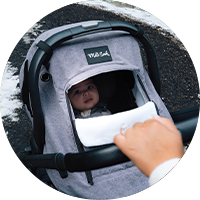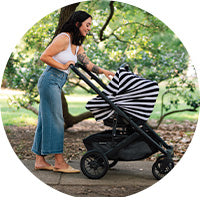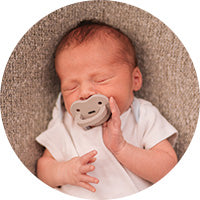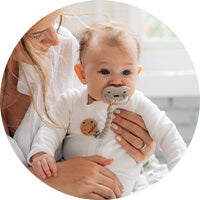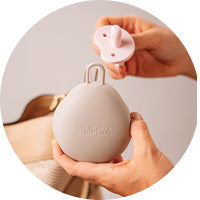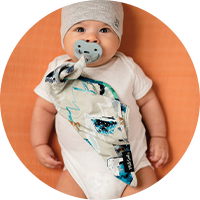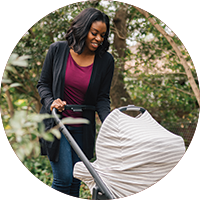Detailed Guide on Breastfeeding for 2025

Breastfeeding remains one of the most important and beneficial practices for both infants and mothers. The bond between a mother and a child is irreplaceable. It is pure and infinite. A child bonds with her mother for 9 months more than the rest of the world. Even when he or she cannot speak, a mother can comprehend each gesture and action. It surely is magical and truly surreal.
This soulful connection can sometimes extend to breastfeeding. As soon as the child is born, many mothers can feed them with the most nourishing and complete diet there can be. We passionately believe that ‘fed is best’. No matter how you choose to feed your little one, you’re doing such an amazing job! We are proud of you! For this post, we do want to highlight a few benefits of breastfeeding specifically.
Breast milk is known to protect the child from many short-term and long-term illnesses. It is seen that children who are breastfed have a lower risk of asthma, obesity, type-1 diabetes, ear infections, and stomach bugs.
One might ask, with the vast development in formula milk for babies, what added benefits does breast milk have? Again, we believe that a fed baby is the most important priority, no matter how you choose to do it! The formula has amazing benefits! Breastfeeding, too, shows great benefits.
The nutritional composition of human milk is exemplary. According to the National Center for Biotechnology Information and the National Library of Medicine, it consists of 87% water, 1% protein, 4% carbohydrates, and various essential minerals such as calcium, magnesium, potassium, sodium, etc. Studies also show that a mother's body makes breast milk according to the specific needs of the baby. In case a baby is ailing, the milk will have a composition that will help him or her fight the disease. Not to forget the cost savings you can have when you feed your baby.
Breast milk is the right temperature for babies and helps to prevent hypothermia. And the best part? You don't need any other supplies - it's readily available!
Coming to the plethora of emotional benefits of breastfeeding leads to emotional bonding for mama and baby. After birth, it’s common for mothers to feel a little lost, and postpartum woe can instigate further hormonal highs and lows.
Breastfeeding your child produces serotonin and endorphins that lead to the feeling of fulfillment and happiness in the mother in many cases. For the baby, he or she can feel secure, connected, and safe.
Breastfeeding surely is a blessing to the mother and child relationship.
If you are pregnant or a new mom beginning to feed your child, then you have come to the right place. In this guide, we will talk at length about breastfeeding and help you sail through this beautiful journey with ease. This is simply because breastfeeding is a skill that requires learning. It needs patience and practice. Every time you feel that you are not able to cope, trust us, it only gets easier. Hang in there, it will get better! Here is everything you need to know about your breastfeeding journey.
How to Prepare Before You Give Birth:
Preparing for breastfeeding before your baby arrives can make a significant difference in how well things go once you're holding your newborn. Chronologically speaking, this is the most logical point to explain first. All you need at this stage is the confidence that you can and will do it. Additionally here are some things you need to do:
- Ask your healthcare provider to refer you to a lactation consultant. They will professionally guide you right from the get-go.
- Needless to say, concentrate on every aspect of your prenatal care. A healthy mother raises your likelihood to give birth to a healthy child. Make sure you are taking a healthy diet and balancing it with all the necessary supplements.
- Let your birthing center (if applicable) know that you would like to breastfeed your child as soon as possible.
- Make the most of the child's first few hours of birth, as it is here that their suckling sense is the strongest.
- Take a doll and practice various feeding positions.
- TALK. Yes, that is the last point! Breastfeeding is not just a mother-child thing. Partners. Husbands and other family members can equally partake in it. Discuss with your family about how you would need them to help you around. Whether it is to bottle-feed your expressed milk during certain hours of the day so that you can rest or doing other chores around the house to appreciate the mammoth commitment you are making to feed your child, etc. The more you talk, the better everyone would be aware of what their roles are around the house and the baby to make your feeding journey easier.
Why is Breastfeeding Important?
We understand that when you read our suggestions stated above, the first things that would come to mind is why do all this? We started by talking about the multiple benefits of breastfeeding your child, but here we will talk in depth about it.
- Breast milk is commonly referred to as ‘liquid gold’: The colostrum that your body produces during pregnancy and just after birth is incomparable when it comes to its nutritional benefits and antibodies. No matter how tiny of an amount your child can take in with each feed, it is enough to provide them with all its benefits.
- It is tailored to suit your baby's growing needs: As your baby grows, the milk's consistency varies too. It has the right amount of water, fat, protein, sugars and other micro minerals that are needed for your child's development. As your baby grows, the nutritional content keeps changing basing on the stage that they are on.
- Breast milk is commonly easier to digest: Breast milk is light, easy on the stomach, and quick to digest. In the one odd case that your child does get colic and excessive gas after breastfeeding, consult your doctor. You may need to alter your diet a bit.
- Breast milk fights diseases: Breast milk is an amazing source of protection for babies. It is unique in its chemical makeup. National Library of Medicine’s research shows that formula-fed babies are more likely to experience ear infections, diarrhea, necrotizing enterocolitis, lower respiratory infections, atopic dermatitis, asthma, obesity, type 1 and type 2 diabetes. On top of that, breastfeeding can help lower the risk of SIDS. It's friendly and comforting to know that your baby can benefit from the unique protections of breast milk.
- It can make life easier for moms: Breastfeeding may feel like more work in the beginning, but it'll be worth it! Establishing a good routine with your baby can make life easier in the long run. You don't have to worry about sterilizing bottles and nipples or having to buy, measure, and mix formula for every feeding. And you'll never have to scramble for a bottle or warm a bottle in the middle of the night!
- It saves you a ton of money: As American moms, we know that formula and feeding supplies can be expensive, sometimes adding up to more than $1,500 each year. While the initial investment may be more than you'd like, the long-term benefits can be worth it.
- It helps mother’s health too: Nursing your little one can offer big benefits for your health! Studies suggest that breastfeeding can help lower the risk of type 2 diabetes, breast cancer, ovarian cancer and postpartum depression. On top of that, experts are still researching the effects of breastfeeding on osteoporosis and weight loss after birth. Multiple studies have reported that breastfeeding mothers experience greater weight loss compared to those who don't. However, further research is necessary to understand if a strong link really exists. While it's still important to maintain a healthy lifestyle, breastfeeding can be an important factor in helping you stay healthy!
Learning to Breastfeed:
Practicing breastfeeding takes time and patience. To get off to a great start, keep these tips in mind:
- Breastfeed as soon as possible after birth.
- Ask for a lactation consultant to come and help you.
- Ask the hospital staff not to give your baby other food or formula, unless it's medically necessary.
- Let your baby stay in your hospital room all day and night so that you can breastfeed often.
We know it can be tricky, but with a little practice, you'll be a breastfeeding pro in no time! We hope these tips will help you get off to a great start with your breastfeeding journey. Have faith in yourself and your baby, and don't forget to ask for help if you need it.
Signs of a Good Latch:
Having a comfortable latch is key for successful breastfeeding! It's more important for it to feel good than to look good. Your baby's chest should also be close to your body. Depending on your and baby's size, you may see some areola with more visible above your baby's lip than below. Their mouth should be full of breast, and if they're latched on correctly, you may see their tongue cupped under the breast. You may hear or see your baby swallow, and you'll also see their ears wiggle. Baby's lips should turn outwards, like fish lips, and you won't be able to see the bottom lip. Lastly, their chin should touch your breast.
Don't be intimidated by breastfeeding! With the right latch, it can be a gentle, rewarding experience.
How to Spot a Bad Latch?
Are you feeling discomfort while breastfeeding? Many moms report tenderness at first, until they and their baby settle into a comfortable breastfeeding position and latch. Once you have achieved a good latch, though, it shouldn't be painful. If it is, your baby may be sucking only on your nipple. Try gently breaking the suction by placing a clean finger in the corner of your baby's mouth and try again. Your nipple should also look round and long, or the same shape as it was before the feeding, not flat or compressed.
If you and your baby are feeling frustrated, take a break. Hold your baby in an upright position skin-to-skin between your breasts and talk, sing, or provide your finger for comfort. Then, try breastfeeding again in a little while. Babies may even start moving to the breast on their own from this position.
If your baby has a weak suck or is making only tiny suckling movements, try releasing the breast and letting your baby start again.
We hope these tips help you and your baby find the perfect breastfeeding position—one that's comfortable for both of you.
Different Breastfeeding Positions:
Moms can find comfort and support their babies in latching on by trying different positions. Don't be discouraged if one method doesn't work - simply switch it up and try something else until you find a position that works for you. It's all part of the process, and with a little patience and experimentation, you'll soon find the best way to feed your baby. Here are some feeding positions you can try with your baby:
Cradle Hold:
Hold your baby with their head nestled comfortably in the crook of your arm and facing you, an easy and common position many moms find comfortable.
Transitional Hold:
Support your baby's head with your palm, held at the base of their neck, when nursing from either breast. This can be useful for premature babies or those with a weak suck, as it provides extra head support to help them stay latched.
Football Hold:
This hold is useful for moms who had a C-section or have large breasts, flat or inverted nipples, or a strong let-down reflex. It's also helpful for babies who prefer to be more upright. With this hold, you can better see and control your baby's head, and keep them away from a C-section incision.
Friendly Tip:
Position your baby at your side, lying on their back, with their head at the level of your nipple. Support their head with the palm of your hand at the base of the head. (The baby is placed almost under the arm.)
Side- Lying Position:
Are you a mom who recently had a C-Section or are looking for a way to get extra rest while your baby breastfeeds? If so, lying on your side with your baby facing you and pulled close to your body is a great way to rest and bond with your newborn. This comfortable position can provide much needed rest for any mom.
How Often Should You Feed and Duration:
Breastfeeding soon after birth is the best way to ensure your baby has plenty of milk. Aim to feed your baby 8-12 times in a 24-hour period - that means frequent feedings in the first few days, every hour or two in the daytime and a couple of times at night. As a mom, you know your baby best, so follow their cues to determine when they're ready to feed. With this friendly advice, you can rest assured that your baby will get the nourishment they need.
Feeding time for your baby doesn't need to follow a set schedule. Allowing up to 20 minutes per breast is a good rule of thumb, but your baby will let you know when they've had enough. If you're concerned that your little one isn't getting enough nutrition, chat with your baby's doctor.
Technological Advances and Tools
Technology continues to play a supportive role in breastfeeding:
- Breastfeeding Apps: There are numerous apps available that can help track feeding times, monitor baby’s growth, and offer support and tips for breastfeeding.
- Breast Pumps: Modern breast pumps have become more efficient and comfortable, offering options for both manual and electric models. Choosing the right pump can help with managing milk supply and enabling feeding flexibility.
- Wearable Technology: Some innovative wearable devices monitor breastfeeding patterns and provide insights into milk production, helping mothers stay informed about their breastfeeding journey.
Breastfeeding in Public:
Though many moms may feel uneasy about breastfeeding in public, it's important to keep in mind that you are simply feeding your baby. Despite the increasing awareness of the importance of breastfeeding, it can still be challenging to do so in public. Still, it's essential to stay confident in your decision and wear that confidence with pride! Here are some breastfeeding tips to help you feel more comfortable in public:
- Wearing clothes that provide easy access to your breasts, such as tops that pull up from the waist or button-down, is a great way to make breastfeeding easier.
- You can also use a special breastfeeding covers around your shoulders. This has to be one of the most convenient ways to feed in public. These covers can also alternate multiple uses apart from just nursing time.
- Slings or other soft infant carriers are great for breastfeeding while on the go, as they help keep your baby comforted and close to you.
- If you’re out and about, don’t forget you can always slip into a women’s lounge or dressing room to feed your little one.
Breastfeeding Tips
Breastfeeding can be a beautiful bonding experience, but it often comes with challenges. These breastfeeding tips will help new moms navigate the journey with ease. Learn how to achieve a comfortable latch, manage common breastfeeding issues like sore nipples, and maintain a healthy milk supply. Discover essential items such as nursing covers, nipple creams, and nursing pillows to make feeding sessions more comfortable. Tips on feeding in public, proper positioning, and establishing a feeding routine are also included to boost confidence. With these insights, you can create a more relaxed and successful breastfeeding experience for both you and your baby.
Find a Comfortable Position: Experiment with different breastfeeding positions (cradle, football hold, side-lying) to find what feels best for you and your baby.
Stay Hydrated: Keep a water bottle nearby and drink plenty of fluids to support milk production.
Feed on Demand: Let your baby lead the way by feeding whenever they show hunger cues, ensuring they're getting enough nourishment.
Get Support Early: Reach out to a lactation consultant if you're struggling with latch or milk supply issues.
Use Nursing Covers for Privacy: If breastfeeding in public makes you uncomfortable, a breathable nursing cover can offer the privacy you need.
Eat a Balanced Diet: Nutrient-rich foods help maintain your energy levels and support your milk supply.
Nipple Care: Use lanolin cream or coconut oil to soothe sore nipples and prevent cracking.
Take Breaks: If you're feeling overwhelmed, try pumping and letting a partner feed the baby to get some rest.
Burp Your Baby: Make sure to burp your baby after feedings to help with digestion and reduce gas.
Trust Your Body: Every mom's breastfeeding journey is unique. Be patient with yourself and trust your instincts.
Moms, you're special! Breastfeeding is an amazing way to relax and handle stress better. It also offers you and your baby a special bond that will last a lifetime. There's nothing quite like the soothing effect of skin-to-skin contact with your baby. Invest the time in yourself and your baby - for your health and for the bond that will last a lifetime.
So moms, whether you're stressed out or in an emergency, breastfeeding is a great option to provide your baby with the perfect nutrition and protection they need. Let's take the time to invest in ourselves and our babies – for our health and the bond that will last a lifetime.





